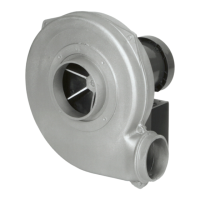Replacement or spare parts may be ordered through
your local Cincinnati Fan representative. (Refer to
drawings that begin on page 7.) The following
information should accompany parts orders:
1. Motor horsepower, frame size, motor speed, voltage,
phase, cycle and enclosure. Motor manufacturer’s
model number from motor nameplate.
2. Fan Speed (if V-belt driven).
3. Fan serial
and model numbers from the fan
nameplate and a complete description of the part.
An adequate stock of repair parts is maintained where
possible. If your fan is vital to production or to plant
operation, it is advisable to have all spare parts on
hand to minimize downtime.
In the event that trouble is experienced in the field, the
following are the most common fan difficulties. These
points should be checked in order to prevent needless
delay and expense.
1. CAPACITY OR PRESSURE BELOW RATING
a. Incorrect direction of wheel rotation.
b. Speed too slow.
c. Dampers not properly adjusted.
d. Poor fan inlet or outlet conditions (elbows,
restrictions).
e. Air leaks in system.
f. Damaged wheel.
g. Total resistance of system higher than
anticipated.
h. Wheel mounted backwards on shaft.
i. Fan not properly selected for a high temperature
and/or high altitude application.
2. VIBRATION AND NOISE
a. Misalignment of bearings, coupling, wheel
or V-belt drive.
b. Unstable foundation or supports.
c. Foreign material in fan causing unbalance.
d. Worn bearings.
e. Damaged wheel or motor.
f. Broken or loose bolts and set screws.
g. Bent shaft.
h. Worn coupling.
i. Fan wheel or drive unbalanced.
j. 120 cycle magnetic hum due to electrical
input. Check for high or unbalanced voltage.
k. Fan delivering more than rated capacity.
I. Loose dampers.
m. Speed too high or fan rotating in wrong
direction.
n. Vibration transmitted to fan from some
other source.
3. OVERHEATED BEARINGS
a. Check bearing lubrication.
b. Poor alignment.
c. Damaged wheel or drive.
d. Bent shaft.
e. Abnormal end thrust.
f. Dirt in bearings.
g. Excessive belt tension.
4. OVERLOAD ON MOTOR
a. Speed too high.
b. Fan over capacity due to existing system
resistance being lower than original rating.
c. Specific gravity or density of gas above
design value.
d. Wrong direction of wheel rotation.
e. Shaft bent.
f. Poor belt alignment.
g. Wheel wedging or binding on fan housing.
h. Bearings improperly lubricated.
i. Motor improperly wired.
j. Defective motor. Motor must be tested by
motor manufacturer’s authorized repair shop.
6
XI.TROUBLE SHOOTING
X. ORDERING REPLACEMENT PARTS

